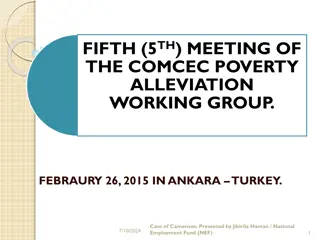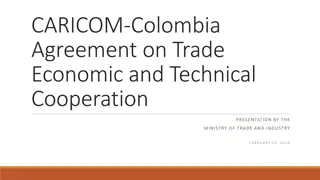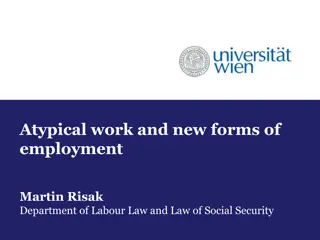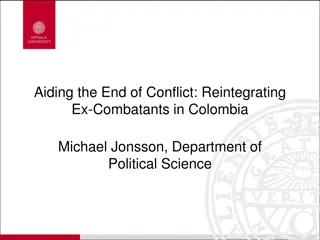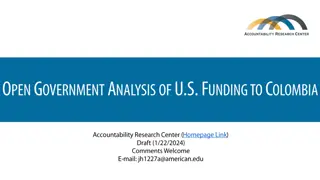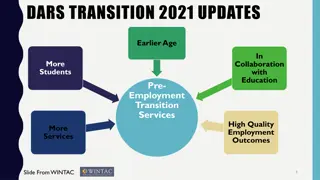Employment, Security, and Development Challenges in Colombia
The report by Joseph E. Stiglitz highlights the challenges faced by Colombia in terms of high unemployment rates, jobless growth, weak wages, and the complex relationship between unemployment and security. The country needs to address these issues to ensure sustainable development and economic stability in the long term.
Download Presentation

Please find below an Image/Link to download the presentation.
The content on the website is provided AS IS for your information and personal use only. It may not be sold, licensed, or shared on other websites without obtaining consent from the author.If you encounter any issues during the download, it is possible that the publisher has removed the file from their server.
You are allowed to download the files provided on this website for personal or commercial use, subject to the condition that they are used lawfully. All files are the property of their respective owners.
The content on the website is provided AS IS for your information and personal use only. It may not be sold, licensed, or shared on other websites without obtaining consent from the author.
E N D
Presentation Transcript
Employment, Security, and Development: Challenges for Colombia Joseph E. Stiglitz Bogota November 2009
The Global Context While the world has pulled back from the precipice and officially the recession in the U.S. and much of Europe is over, unemployment is likely to remain high, and growth is likely to remain weak for an extended period of time: a Japanese- style malaise Many bumps in the road Both for financial markets and the rest of the economy
Asia has staged a strong recovery But prospects of addressing global imbalances remain weak Developing countries need to prepare themselves for adjusting to this new normal Especially important for countries that have faced high levels of unemployment
Unemployment Has long been higher in Colombia than elsewhere in Latin America During late 1990s crisis, rose close to 20% But increases in this crisis have made it highest rate in Latin America 12.8% Of those employed, 46% were under- employed New part-time workers especially strong in recession
Jobless Growth Flip side of high productivity growth Between Dec 2002 and Dec 2008, GDP grew 36.4%, employment 7.9% In agriculture, in same period, output grew by 19%, employment fell 5.5% In manufacturing, from 1998 to 2008, output increased by 23%, employment fell by 13% Many jobs created were low quality, informal services 1 million self-employed out of 1.3 million new jobs
Weak Wages 5 percentage point increase in share of profits Wages Mixed Incomes National Income
Unemployment and Security Two way relationship But in past, stronger relationship in one direction: unemployment causes violence Reduction in violence has not led to increase in employment
Explanations Minimum wage Not increased substantial in pesos: 5% since 2003, adjusted for inflation Labor market inflexibilities Were reduced Increasing social cost of employment Not increased substantially
Increased Cost of Labor Relative to Capital Tax policy Real Exchange rate Highly volatile but for importing capital goods, what matters is high points Strong appreciation since 2003
Explaining Exchange Rate Changes Short term capital movements Exogenous shock Depreciation after Lehman Brothers global phenomena Back to pattern of appreciation Long term natural resource curse (Dutch disease) Employment creation common problem for natural resource exporter
Solutions Reform Tax Policy to encourage employment Exchange rate interventions Capital inflow tax to stabilize exchange rate Exchange rate interventions to depreciate currency Part of explanation of East Asia s success One of acceptable instruments of industrial policy under WTO Broad-based nature has distinct advantages
Problem Bilateral Trade Agreement with US presents problems Not really a free trade agreement US continues to subsidize agriculture And intervenes in many areas besides trade (investment, intellectual property) Imposes intellectual property regime that even America is now rejecting Job destruction in agriculture
Bilateral Investment Agreement Not balanced rights without responsibilities Imposes huge risks on countries (Indonesia, Argentina) Process of adjudication not up to 21st century standards of justice Restricts ability to impose capital controls Worse than other bilateral agreements
Response to Crisis Those countries that responded to crisis with large fiscal and monetary measures have been most successful in responding to crisis Smallest increase in unemployment Quickest recovery Difficult for small, open countries
Stimulus Worries about deficits exaggerated What matters is a country s balance sheet assets and liabilities Debt financing creates a liability But if spending is for infrastructure, education, or technology, there is a corresponding asset High return assets make a country stronger in the long-run and maintain growth in the short-run Colombia, like most other countries, needs to prepare for climate change
Restructuring the Colombian Economy Those countries that had a diversified export base have also weathered the storm best Asia is quickly recovering from crisis Those countries that have had active industrial policies (Brazil, East Asia) have also done better, both in the short-run and the long Including export-oriented industrial policies Have been a central part of all successful economies Both in Asia and in Latin America
Industrial Policies Finance Through development banks Targeted government assistance Public/private partnerships Including at local/regional levels Important to encourage local entrepreneurship Too many countries have put excessive focus on foreign direct investment Need balance
Avoiding Dutch Disease Not just a matter of exchange rate management High volatility as a result of volatility of commodity prices High economic cost of volatility Need to manage through stabilization funds
GDP is especially bad measure of output for natural resource country Doesn t reflect sustainability Doesn t reflect depletion of natural resources and degradation of environment Natural resource countries are often marked by high inequality GDP per capita does not tell what is happening to median income Problem in both U.S. and Colombia U.S. median income falling, while GDP per capita increasing
Unless assets below the ground are converted into assets above the ground, country will be poorer
A New Agenda for Colombia Balanced role between markets and government Big lesson of crisis: markets are not self-correcting, often not efficient Financial markets often fail to allocate capital in ways that promote growth and stability Often fail to manage risk well Engage in anti-competitive practices (stifling creation of an efficient electronic payments system) Often engage in predatory lending and other exploitive practices Regulation can contribute to growth and stability and even good innovation Most of their innovation was circumventing accounting, financial, and tax rules and regulations Didn t innovate in ways to help people manage risk or to improve efficiency of resource allocation
Other Roles of Government Social protection without protectionism Macro-policies focused on stability, growth, and employment creation Micro-policies that promote education, technology ( putting people first including focusing on employment) In every successful economy, markets have been at the center, but government has played a pivotal role in each of these areas



